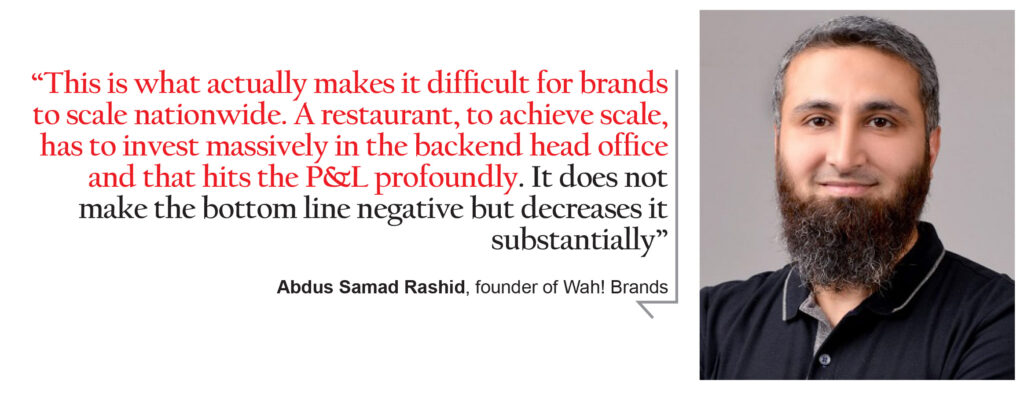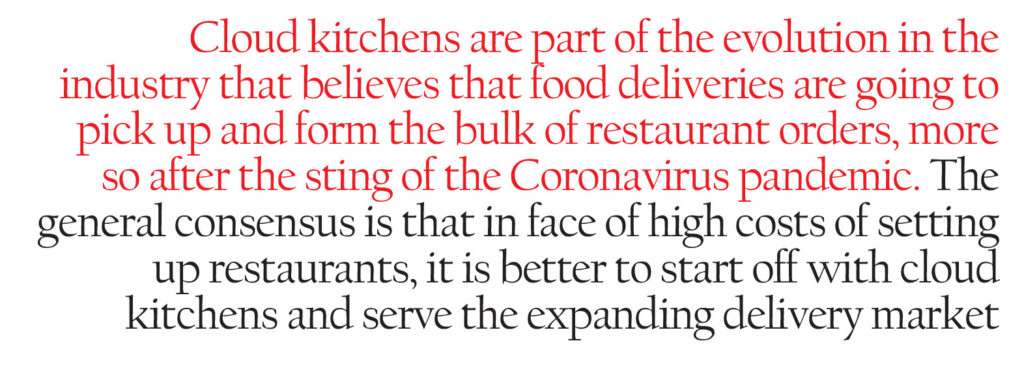A revolution is brewing in Pakistan’s $20 billion restaurant industry. Already, there are three cloud kitchens that are making inroads into the industry and over time will change the way Pakistanis eat out. What are cloud kitchens?
Tucked away in remote alleys, away from the hustle and bustle of main dining districts, these kitchens cater to what is currently a relatively small segment – people that want good, quality food but do not want to go out to eat. How does it work? Well, the kitchens avoid traditional restaurant costs like high rent real estate, interior decoration, utilities, and staff like waiters and managers. What do the customers get? They avoid problems like selecting a place, making a reservation, possibly waiting, dressing up and making plans.
Through cloud kitchens, these people can have their food delivered to them within a desirable time and at a desirable cost. This is the segment that forms a market for food delivery for restaurants and allied players, such as tech and logistics companies.
Everyone saw that coming. It was going to happen eventually that food delivery was going to become as important a component of the restaurant business as fine dining. But the change came early because of the Covid-19 pandemic.
But even without the pandemic, it was going to happen sooner or later because of the evolution in the restaurant business that created demand and supply issues for the industry. These kitchens do not only serve the consumer end of the market. It also serves, perhaps more importantly, the producers of food, the restaurants and their ends.
But what are cloud kitchens and how they are going to change the industry landscape of Pakistan? It is important to understand the industry dynamics and what has been happening in the industry.
The state of the industry
Restaurants operating with the traditional dine-in model have always been a happy business to be in. The business has seen growth and more growth ever since the industry took shape in Pakistan. But with the advent of technology, restaurants have moved from fine dining to online delivery model helped by the increasing internet availability, sophisticated technology and a population that is savvy about all of the above.
The industry has evolved from being composed of restaurants only to include allied players such as technology and logistics companies moving in specifically to cater to deliveries for these restaurants, thereby creating multiple industries within an industry.
Food orders moving online means that restaurants, save a few, that had been originally designed to cater to a population seeking dining experience at the restaurants, are now offering online deliveries, thereby creating an issue of underutilization of capacity at these restaurants. So when you are setting up a restaurant today, the costs are massive.
It is increasingly becoming more unfeasible because restaurant customers have decreased and have moved on to online deliveries.
“When you are setting up a restaurant, you have to worry about the elevations, the design, the ambience, the seating, the furniture, the artefacts. It is an expensive proposition today, especially when you are not going to have customers or have less customers,” says Kamran Sheikh, founder of Lahore-based Veranda Bistro restaurant.
“Right now, all the restaurants are operating at reduced capacity and now because of the pandemic, you want them closed earlier. Today, it does not really make sense to set up a massive infrastructure only to get returns that are not as great as they used to be.”
The problem is the same for all sorts of restaurants. Setting up an entire restaurant is an expensive task. The troubles are more profound when the restaurant, fine dining, fast food, new, big, or small, has to scale to other geographies. The problem is not that the restaurants do not have the capacity to scale. The problem is that it does not make sense for them to do so because of the new demand created by delivery orders. And new demand requires new supply. This is where cloud kitchens come in.
The Cloud Kitchens
Cloud kitchens is a new global phenomenon whereby multiple delivery/takeaway only restaurants operate from a common vicinity. Unlike restaurants, there is no front end, and no facade. A kitchen does not need a front location that would be ridiculously expensive to lease.
“We have a restaurant brand that pays Rs1.5 million in monthly rentals. Now when I take that brand in another geography in a cloud kitchen, I get a cheap rental space. That space would usually be one-tenth of the total cost of the restaurant at a prime location. This is the fundamental concept of a cloud kitchen, that you take a chep space and start selling food from there,” says Abdus Samad Rashid, founder of Karachi-based Wah! Brands, a multi-brand restaurant chain operator.
Cloud kitchens are all about optimising restaurant operations cost and reduce focus on brick-and-mortar and more on deliveries, which can all be done through a kitchen. It is the same for restaurants looking to expand, as well those looking to start new business in the restaurant industry. Starting a restaurant business requires financial heft and is therefore a risky business. What if it does not work? For expanding businesses, cloud kitchens are a low cost alternative.

Look at it this way, if a restaurant opens up in Lahore in the Gulberg area, and suddenly gains a lot of popularity, people will come there to eat, but they will also want to order from there. But will the eatery be able to deliver to far flung areas like Wapda Town or Johar Town? For that matter, would they even be able to deliver to somewhere like DHA? To cater to these areas, they would have to open new branches – an expensive endeavour. Instead of this, they could simply use cloud kitchens.
“As compared to setting up a complete brick-and-mortar restaurant, setting up a kitchen only is about one-third of the total cost. So it becomes a favourable proposition all of a sudden,” says Kamran Sheikh.
For consumers, Cloud kitchens provide a price and service differential. Since it will be a designated delivery kitchen; delivery times will be relatively lower than normal restaurants plus the cost savings on overheads can allow exclusive deals to be made.
Cloud kitchens are part of the evolution in the industry that believes that food deliveries are going to pick up and form the bulk of restaurant orders, more so after the sting of the Coronavirus pandemic. The general consensus is that in face of high costs of setting up restaurants, it is better to start off with cloud kitchens and serve the expanding delivery market. For the same reason, in case of expansion, it is troublesome to open brick-and-mortar restaurants and it’s better to have an online presence.
“Contrary to the conventional wisdom, deliveries are not going to have a limited scope. They have a huge scope. Already the fast-food industry, 30-40% or maybe even more is in the deliveries business than before,” says Kamran Sheikh.
“The food delivery market is evolving every year, whereby demand for online food ordering and on-demand delivery is growing. To cater to this, managing demand for higher quality and more diverse food options while economically encouraging restaurants, cloud kitchens will help the restaurant industry grow,” said FoodPanda CEO Nauman Sikander.
In face of the said challenges of supply and demand, two cloud kitchen companies, Karachi-based Hotpod and FoodPanda, are offering cloud kitchen services to food entrepreneurs to start new businesses, services for up and coming restaurants looking to launch and existing restaurants looking to scale. Both are offering unique solutions on the same pitch: setting up a new restaurant is expensive and cloud kitchens offer convenience at a less cost and are more agile in operations. The restaurateur does not have to focus on operations. Instead, he should do what he does best; that is to cook.
It is not hard to miss that cloud kitchens have been operational at homes, with home-based chefs selling food via social media channels and unorganised logistics. It is a cloud kitchen but operating from home, meaning if the home-based cloud kitchen wants to expand, they would either have to set up their own brick-and-mortar infrastructure everywhere they go, or set up cloud kitchens. In either case, they would be incurring avoidable capital expenditure which is a lost investment in case the business does not do well in a new geography. This is where these two startups come in, with a network of plug-and-play kitchens for brands to start from scratch or expand at a very low cost and hedging them massively.
It is a new starting point for everyone in the industry even globally. There is no success story yet. Only experiments and learning through trial and error. In Pakistan as well, Hotpod has recently completed its pilot but is taking things slowly. Foodpanda on the other hand is still carrying out its pilot. One likes to call itself the digital franchisee, the other thinks that it is creating a kitchen revolution. How do their business models and value propositions vary? Profit delves into details.
Hotpod – Franchising 2.0
Helmed by the founder of Wah! Brands, Abdus Samad Rashid, Hotpod’s idea is to be a digital franchisee for delivery-only services. If a restaurant wants to expand into multiple geographies, it can give a franchise to Hotpod that will then operate it in its cloud kitchen in a particular geography. But it is not as simple as that. Where Hotpod plans to get franchises of different brands to operate from its cloud kitchens, it also seeks to utilize the space of its cloud kitchens optimally and reduce costs as much as possible, and therefore seeks to have multiple brand franchises operate from a single cloud kitchen.
What Hotpod wants to do is that it is going to operate multiple brands from the same location and those multiple brands will not be theirs. Save the ownership of the brand, from cooking to deliveries, Hotpod is going to do everything that a traditional franchisee does, except that it is for the delivery-only customers, for brands looking to scale at minimum costs and risks.
So if a brand has a brick-and-mortar restaurant in Lahore’s DHA neighbourhood, it is not operationally possible to deliver in Johar Town, though the demand for its products might be huge in Johar Town. The brand either has the option to open up their own restaurant or cloud kitchen, or partner with Hotpod’s plug-and-play kitchen. Like any other franchise, Hotpod staff would be trained by the brand as per its standards.
Another challenge is that whenever a restaurant is going into multiple geographies, it needs a back office to create a supply-chain nationwide that faces financing, marketing and administration challenges, besides making technology available for, let’s say, POS payments. That requires an entire back office structure that the brand needs to invest in; a capital expenditure that is not revenue generating.
“This is what actually makes it difficult for brands to scale nationwide. A restaurant, to achieve scale, has to invest massively in the backend head office and that hits the P&L profoundly. It does not make the bottom line negative but decreases it substantially. So much so that it takes years to recover. So swift expansion is not possible for many restaurants,” Samad says, explaining that the moment restaurants cross that threshold of scaling outlets, they get profitable at the head office as well.
It is not therefore possible for each brand to scale efficiently and swiftly. So if the brands that want to scale but do not have the capacity to do so, for them Hotpod is the low cost alternative that they can choose.

“Our model is a B2B (business-to-business) play. We take a restaurant franchise on a low cost real-estate. On utilisation we create value that we optimise and make our utilisation as efficient as possible. From the efficient utilisation, the cost absorption comes. There is the real-estate cost absorption and there are all other fixed costs absorption on the basis of which you can give royalty to brands, earn yourself and give money to the aggregator as well,” says Abdus Samad with conviction of an experienced restaurateur.
For a proposition that appears savvy, Samad’s rationale for this model appears savvier. That if someone is already operating three pizza brands from three locations, it can be consolidated to a single location with a single team that is trained to do the same that three teams were doing separately, but now the cost will be divided into three brands.
“So if it was one brand that was operating that cloud kitchen, it was going to bear all the cost of a cloud kitchen. If we divide that to three brands, that is where the utilisation comes in,” he explains.
So let’s say if Hotpod is operating three pizza brands at a single cloud kitchen, it would be using one team and one equipment for cooking pizza products of each brand. The problem, rather a challenge here is that the spirit of franchising is the ‘standardisation’ of food products. Brands try to ensure that across all their franchises, the products are the same in terms of quality, taste, presentation. In doing so, they have their own brand recipes, intellectual property that makes them the brands that they are, different from others. So when you are operating three brands using the same equipment, how do you ensure the sanctity of each brand?
For starters, Samad realises that the challenge is real and needs to be addressed seriously. But he insists that technical segmentation at the equipment level is possible to achieve, and each brands’ sanctity can be protected.
“It is an operational exercise in capacity, exercise in equipment operations. We are creating a science as to how to make it possible. From our experience operating restaurants, we know that it is possible,” he adds.
“Now, many concepts in food are dine-in concepts. There are certain delivery trends in our market that we have seen and of course we have seen and we know about the trends in the market. We look at the global trends as well. For instance, pizza is number one in delivery. It is number one in Pakistan as well as globally. Second category is burger and chicken. So we are not going to offer dine-in concepts for delivery. It would be food categories that are on the top in delivery trends,” Samad explains.
This is all in the testing phase, however, and nothing is concrete yet. What is going to work, what is not going to work, the road to clarity is far away. Though Hotpod has one kitchen that is live in Karachi’s Pakistan Employees Cooperative Housing Society (P.E.C.H.S) neighborhood and houses seven brands, the maximum capacity it wants to achieve is upto 20 brands in one kitchen to make it a lucrative business, while Samad discloses that at 10 brands in one kitchen, delivering 25 orders per day per brand at the ticket size of Rs800 makes the business break even.

As for signing up with brands, it is going to be a revenue sharing model. Based on their food costs and their aggregator commissions, Hotpod currently pitches brands a revenue share between 6-13%, and that is without any operational headache for the brand.
“We are taking it very slow and steady, we are evolving our systems” is what Hotpod’s current focus is right now. There are likely going to be a lot of mistakes and learnings ahead. But one thing is certain that as Hotpod grows, even nominally, it would be relying heavily on data and driving value from it for growth.
Strength in data is what makes the next company, FoodPanda, more formidable than HotPod.
FoodPanda – The Kitchen Revolution
Over the years FoodPanda has been operational in Pakistan, it has developed its strength in data. It’s data gives live trends of what’s happening in the restaurant industry. How many people are ordering in a day? What’s the most ordered item? Which brand fares better than the other in a particular category? Which geographies are underserved by a particular brand? It has the micro-level data that has driven it to create its own value proposition to brands and suggest to them where they should expand, and provide them with cloud kitchens for the expansion that they recommend to these brands.
FoodPanda is most likely going to woo brands that are already with them on their platform for deliveries, that are doing well and are not present in that geography.
FoodPanda’s Director of Operations in Pakistan, Syed Aemad Mehdi, told Profit that delivery optimised kitchens are a win-win for both customers and restaurants. “To engineer restaurant growth, we identify areas with high population density and lesser restaurant coverage. Data driven decisions regarding customer order behavior, mix of cuisines preferred and restaurant coverage helps in creating the perfect selection for our stakeholders.”
But unlike Hotpod, FoodPanda does not operate kitchens itself. It’s pitch to the clients is that you should expand to a particular geography because we know from our data that trends are favourable for your brand in that particular geography. FoodPanda then goes on to do all the heavy lifting of setting up a kitchen for its clients, which are operated by these clients themselves. FoodPanda then takes care of the deliveries.
Foodpanda told Profit that it takes care of all the initial investments, from choosing the location, to construction to all fixtures and fittings. It provides new entrants as well as established restaurants with a perfect starting point, engineering restaurant growth. Restaurants do not pay any rent, or any onboarding fee; they are only charged a set percentage and the utilities they consume, thereby reducing their overhead costs.
Though the management of the company did not disclose particular details about percentages, Profit learnt from a source that the percentage on sales can go as high as 40% with FoodPanda.
FoodPanda positions itself from the position of strength and says that it is better than other cloud kitchens because of the expertise it possesses. Starting a kitchen requires a strong market presence and established relationships with a chain of vendors. Coupled with the logistical expertise of the company that has one of the largest fleets in Pakistan with more than 15,000 active riders nationwide and data driven insights, FoodPanda claims it has the edge that no one has and that it helps restaurants in growing more than 100% YoY without any startup cost or barriers to entry.

While both these startups are trying to do the same thing for restaurants, their varying model does not necessarily put them in competition with each other. They both are happy alternatives for restaurants. For HotPod, FoodPanda is even a partner in making the deliveries happen through its fleet, besides Hotpod’s own fleet of riders.Though HotPod stresses that it wants to keep its rider fleet low because it does not want to be identified as a logistics company.
Besides these two, another Cloud-kitchen startup, Byte, has also made forays into the space with a radically different model than the other two: it has ventured into the space as a delivery-only virtual restaurant, handling everything from cooking to deliveries on its own through its cloud kitchens. Byte, which is backed by Silicon Valley-based startup incubator Y Combinator, is based in Lahore and has operations in Lahore only.
Not much is known about the startup except that it plans to use the cost-effective metrics of operating cloud kitchens to provide low-cost food from a standardised menu all across where it operates for deliveries only. The startup is currently operating in stealth mode and refused Profit’s request for an interview.
Cloud kitchens are going to change the industry landscape in Pakistan. Though it is too early to say how. As mentioned earlier, the startups are all either in pilot or stealth mode or have recently come out of pilot. Whatever the case, it is too early to call it a success or a failure. However, the consensus in the industry is also that the food delivery business is heavily dominated by kingpins in the food business, McDonalds, KFC, Domino’s and the likes.
These are restaurants that have their own franchises, logistics in place for deliveries. They have ecosystems of their own and have reached scale. Whereas FoodPanda and Hotpod’s pitch is to those brands that are looking to scale. Whereas Byte is directly in competition with all the restaurants that are offering food in similar categories.
Though still a speculation, industry experts believe that the success of cloud kitchens is going to be dependent on the big players in the delivery space such as the aforementioned McDonalds and KFC, and if these restaurants see value and choose to hop on with any of the aforementioned startups.
Comments are closed.




















Dear Taimoor,
It was a good read but too long. You could have avoided a lot of repetition and articulated this piece better.
I like the content, but the same things written over and over again lost my attention in the middle. Hope you don’t mind a constructive feedback.
Regards
Duly noted! Will try to avoid repititions ahead. Thank you for making the effort to help us improve. Hopefully, you will see better articulated pieces ahead.